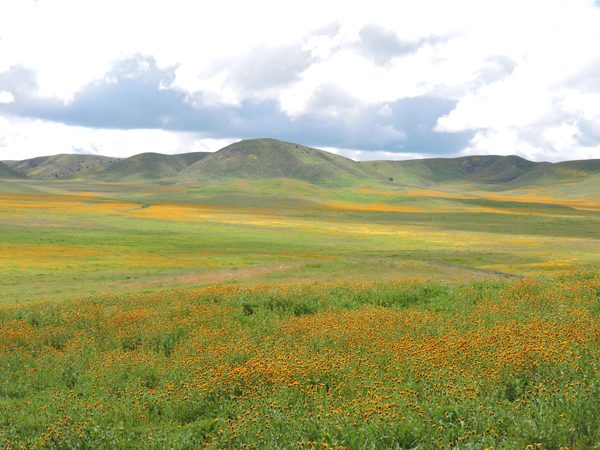BLM issues report summarizing opposition to fracking, drilling public lands

The 2017 superbloom at the Carrizo Plains National Monument. Photo by Editor Skye Pratt.
–The U.S. Bureau of Land Management recently released a report summarizing thousands of public comments it received as part of the agency’s analysis of oil drilling and fracking across more than one million acres of public and private lands in central California.
The BLM received 8,399 comments during the 30-day comment period that ended in September. According to the BLM report, only two of the unique comments (0.2-percent) expressed an opinion “in favor of oil and gas exploration and development.” The vast majority of comments outlined concerns about the controversial practice of fracking, whereby large volumes of chemicals and water are injected into the ground to stimulate oil and gas production.
“The BLM report proves what we already know – that residents and businesses throughout the central coast are overwhelmingly opposed to drilling and fracking our region’s iconic landscapes,” said executive director Jeff Kuyper of Los Padres ForestWatch, the nonprofit organization that is spearheading community efforts in response to the BLM’s plan. “The future of our schools, conservation lands, military bases, winegrowing regions, state parks, lands adjacent to the Los Padres National Forest and Carrizo Plain National Monument, and other important areas are all at stake. We encourage everyone to continue to speak out against this proposal once the draft environmental statement is released in 2019.”
The large number of comments were lodged despite the agency’s unusually short time frame for submitting comments – only 30 days. The comment period was even shorter when taking into account that BLM didn’t release detailed mapping data showing which parcels would be open to drilling and leasing until halfway through the comment period. The BLM refused repeated requests by local elected officials, ForestWatch, and other members of the public to extend the comment period.
The BLM’s scoping report categorizes all of the public comments BLM received during the comment period. The most popular category of public comments was “water resources.” Studies have found potentially significant impacts to water quality as a result of fracking, including contamination of underground aquifers and surface waters.
In a letter to BLM dated Sept. 7, 2018, the U.S. Environmental Protection Agency noted that it had previously “expressed remaining concerns that surface water and ground water may not be adequately protected” during drilling and fracking operations in the analysis area, which covers nine counties in Central California including Santa Barbara, Ventura, and San Luis Obispo. The EPA letter cites potential impacts from “leaks and spills; production and disposal of produced water or processing waters; use of pits, underground injection control (UIC) wells, infiltration and evaporation ponds; production wellbore integrity; closure requirements; pipeline use; and impacts associated with restimulation and abandonment of existing wells.”
Other top categories of public comments identified in the BLM scoping report include:
- Water resources (124)
- Request for extended comment period (78)
- Opinion – opposed to hydraulic fracturing (75)
- General (57)
- Climate and Air Quality (46)
- NEPA Process (43)
- Seismic Activity (41)
- Cultural Resources (38)
In addition to the EPA, other agencies and elected officials expressed concern to BLM during the comment period. Governor Jerry Brown and the directors of six California resource agencies – the California Department of Conservation, the California Department of Fish and Wildlife, the California Department of Water Resources, the California Department of Parks and Recreation, the California Air Resources Board, and the State Water Resources Control Board submitted a joint letter identifying “the potential for significant adverse impacts to California’s air quality, water quality, sensitive habitats and residents.”
The Department of the Army wrote a letter stating, “Any encroachment or degradation of training ranges, training sites, or airfield operations at Camp Roberts or Camp San Luis Obispo by any proposed oil tracking operations will be highly contested by the California National Guard.” The letter also points out that the two military training sites also derive their domestic water from underground wells, and that “[a]ny contamination of the aquifer supplying this water would have significant negative consequences on the military mission.”
Congressman Salud Carbajal, whose district covers the affected public lands in Santa Barbara, San Luis Obispo, and portions of Ventura county, submitted a letter requesting a 30-day extension of the comment period, citing the region’s “abundance of ecologically sensitive areas and significant agricultural resources interwoven with vital water aquifers and numerous active fault lines.” The Congressman noted the controversy surrounding fracking, threats to the environment and public health, and the need for the public and local governments to have enough time to understand and properly comment on the proposal.
Four members of the California legislature whose districts cover the affected lands – Senators Bill Monning, Hannah-Beth Jackson, and Henry Stern, and Assemblymember Monique Limon – wrote, “This proposed plan is in direct contravention of California’s goals and policies to mitigate greenhouse gas emissions and protect public health.”
County Supervisors Steve Bennett (Ventura County) and Joan Hartmann (Santa Barbara County) wrote letters expressing concerns about the BLM’s drilling and fracking plan. The Santa Barbara County Planning & Development Department outlined several concerns in its Director’s letter to the BLM, including the public disclosure of chemicals used in fracking operations, water contamination, water consumption, waste injection into aquifers, oil spills, air quality, greenhouse gas emissions, increase in seismic activity, wildlife impacts, and noise impacts.
The City of San Luis Obispo expressed concern to BLM about several city parcels opened for drilling and fracking, including the Reservoir Canyon Natural Reserve and Irish Hills Natural Reserve. In addition, the city urged BLM to evaluate the impacts of allowing drilling and fracking near critical city water supplies at Whale Rock Reservoir, Lake Nacimiento, and Salinas Reservoir.
The City of Lompoc expressed concern that several parcels slated for drilling and fracking are located within city limits, including the Lompoc satellite campus for Allan Hancock College, which contains a state-of-the-art Public Safety Training Complex that houses the college’s police, fire, emergency medical services, and environmental technology programs. In noting that the city’s nearest water well is just 290 feet from one of the BLM’s drilling and fracking areas, the city notes: “The City of Lompoc relies solely on ground water from a discrete aquifer for its water source. Any potential for contamination of that aquifer could have far reaching impacts on the health and welfare of Lompoc’s residents and must be specifically evaluated. The city is informed the potential oil and gas fracking activities may be in the immediate vicinity of the city’s well field – its sole source of municipal water supply. As such, the city intends to take an active role in review of any action to allow fracking that may interfere in any manner with the city’s water supply.”
Seven Native American tribes and organizations – Santa Ynez Band of Chumash Indians, Wishtoyo Chumash Foundation, Barbareno Band of Chumash Indians, The Chalon Indian Nation of California, North Fork Rancheria of Mono Indians of California, Picayune Rancheria of the Chukchansi Indians, and Table Mountain Rancheria – expressed concerns about the BLM’s drilling and fracking plan. “As the indigenous people of this area, we have a cultural mandate to ensure the protection of all our relatives, especially those that are endemic and endangered in our homelands. This project will also degrade large areas that support habitat for wildlife, native vegetation and protected species. Fracking and oil drilling are antithetical to the relationships that Chumash people have developed with our homelands and waters over millennia,” wrote one of the groups.
Two schools – The Thacher School (Ojai) and Cate School (Carpinteria) – expressed concern about the proximity of drilling and fracking lands to their campuses. “All of these core school activities would be gravely compromised by the presence of fracking and drilling under, on, or near our campus,” wrote one of the schools.
Twenty-seven NGOs submitted concerns regarding the BLM’s drilling and fracking plan, including (in alphabetical order): California Geological Survey, California Native Plant Society, California Wilderness Coalition, Californians Against Fracking and Dangerous Drilling, Carrizo Plain Conservancy, Citizens For Responsible Oil & Gas, Citizens Planning Association, Coalition to Protect SLO County, Commercial Fishermen of Santa Barbara, Conservation Land Group, Inc., Defenders of Wildlife, Environmental Defense Center, Heal the Ocean, Keep Sespe Wild, Los Padres ForestWatch, National Parks Conservation Association, North County Watch, Ojai Valley Defense Fund, Rooted in Resistance Political Action Group, Santa Monica Mountains Fund, Sequoia ForestKeeper, Sierra Club, The Center for Biological Diversity, The Nature Conservancy, The Wilderness Society, The Wildlands Conservancy, and Tribal Trust Foundation.
Four oil and gas industry associations submitted comments in favor of increased drilling and fracking, including American Petroleum Institute, California Independent Petroleum Association, Western Energy Alliance, and Western States Petroleum Association.
The BLM will use this first round of public comments to define the scope of the Environmental Impact Statement that evaluates the impacts of drilling and fracking in central California. Officials expect to release the draft EIS in February or March 2019 followed by a 45-day comment period and public meetings.




















